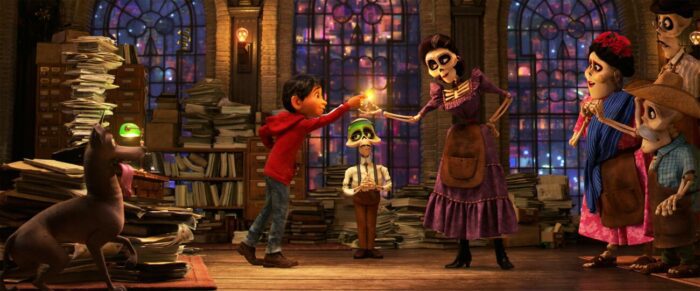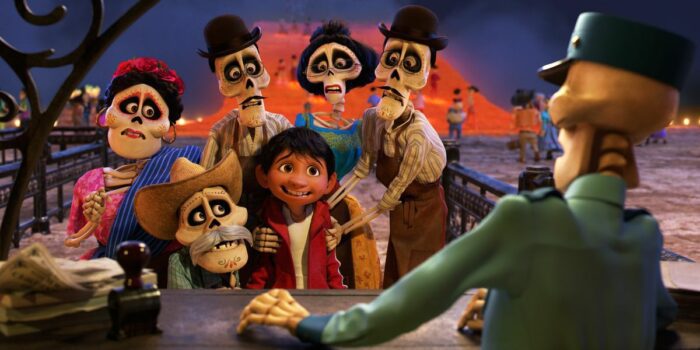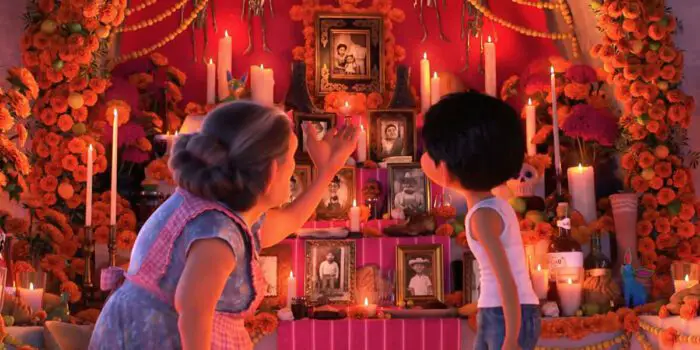When you think about animated gateway horror, what comes to mind? For most of us, it’s children’s horror movies like The Nightmare Before Christmas and ParaNorman, but I’d like to suggest an outside-the-box film that should also be on that list: Pixar’s Coco. To be fair, I don’t think Coco is really a horror movie the way those more traditional gateway films are, but nevertheless it has some surprisingly deep points of contact with the genre. And I’m not just talking about the skeletons (although that’s definitely part of it)! This movie has a key thematic connection to horror as well, and when we combine it with the more obvious parallels, we get an almost perfect gateway to the movies we love.
The Plot of Coco

Coco is set in Mexico, and it centers around a boy named Miguel Rivera who wants to be a musician. However, his family isn’t so keen on the idea. Many years ago, Miguel’s great-great grandfather left his wife and daughter to become a professional musician, and ever since then, the Riveras have been adamantly against anything even remotely musical.
But Miguel is the exception. He loves music, and he’s even secretly taught himself how to play the guitar. One day, while trying to pursue his dream, he inadvertently transports himself to the Land of the Dead, an afterlife realm where all the residents are skeletons, and the only people there who can send him back to the world of the living are his dead relatives. They agree to do it, but they place a massive condition on his return: he can no longer play music. Predictably, he refuses, so he runs away and tries to find his long-lost great-great grandfather, who he thinks will let him go home and still be a musician.
That kicks off a really fun adventure for our main character, but it has a bit of a dark side too. Miguel has to get back to the world of the living before sunrise, and if he doesn’t, he’ll die and stay in the Land of the Dead forever. In fact, before he even runs away from his family, he realizes that he’s already turning into a skeleton, and as the film goes on, the transformation slowly progresses and takes over more and more of his body.
There’s of course a lot more to Coco than just that brief plot description, but we don’t need to go over every single narrative thread in the movie. That little bit is enough for our purposes here, so without further ado, let’s explore the ways this film can help usher young kids into a life of horror fandom.
Skeletons and Body Horror

Most obviously, Coco is filled with the kind of imagery we often find in horror movies. Like I said, everybody in the Land of the Dead is a skeleton, and at one point in the movie, Miguel even paints his face like one so he can blend in with them. Granted, these skeletons are more festive than scary, but they’re still skeletons. So for viewers who aren’t used to the creepy visuals we often get in horror films, the residents of the Land of the Dead are a great way to start getting acclimated to this key element of the genre.
In particular, I think Miguel’s slow transformation into a skeleton is especially effective in this regard. Since the residents of the Land of the Dead are supposed to be skeletons, their appearance isn’t too scary. However, Miguel is supposed to be a living boy, so when his body slowly changes and becomes more and more like theirs, it turns the imagery into something legitimately horrific (but toned down for kids, of course).
In fact, you could even say that Miguel’s transformation into a skeleton is borderline body horror. It’s pretty reminiscent of movies like The Fly, Ginger Snaps, and Tetsuo: The Iron Man, where the horror revolves around people’s bodies slowly changing and turning into something monstrous. Again, the terror is very toned down in Coco, so it doesn’t pack anything close to the punch of those films, but for children who are just getting into horror, it’s a great introduction to this time-honored genre trope.
Dealing with Death

If the skeletons were the only similarity Coco shared with horror movies, I think that would be enough to classify it as a gateway horror film. But there’s more. Not only does Coco have visual parallels to horror, but like I said before, it also has a key thematic connection to the genre: it’s about learning how to cope with death.
Admittedly, this probably isn’t the first thing that comes to mind when most people think about horror movies, but let’s go through it step by step. Most horror films center around some sort of deadly threat, and when we really get into them, we feel like we’re right there with the characters experiencing that threat ourselves. Even though we know it’s just a made-up story, we still become scared of the killer or monster, and we mourn its victims’ deaths.
In other words, we experience a tiny fraction of the stress we’d feel if we really were in that kind of life-or-death situation, so we have to find a way to cope with it. And as many horror fans recognize, that in turn teaches us how to cope with various kinds of stress (including death) in our real lives. It’s kind of like when baby animals play fight. They’re having fun, but they’re also practicing and honing their fighting skills for the future. Similarly, when we watch horror movies, we’re having fun too, but just like those baby animals, we’re also practicing and honing our ability to cope with death for the day when we lose a loved one in real life.
And Coco does something very similar. At its core, Coco is essentially about family. In the movie’s first act, Miguel butts heads with his parents and his grandmother, and he even tells them he doesn’t want to be part of their family anymore. However, his experiences in the Land of the Dead teach him to love and appreciate them, so the film ends with all the Riveras getting along and living happily ever after.

But if you pay close attention, the movie isn’t just about loving your living family members. Miguel’s adventure in the Land of the Dead also teaches him the value of remembering his relatives who’ve died, and this theme comes to the fore in a big way at the end of the film. In one of the final scenes, we see Miguel adding his grandmother’s picture to their family’s ofrenda, a place in their home where they honor their deceased loved ones, and he tells his newborn sister who all the people in those pictures are.
In other words, not only has he learned to remember his dead relatives, but he’s also teaching his sister to do the same, and that’s really important. While nothing can make the pain of losing a loved one go away entirely, cherishing their memories in our hearts and sharing those memories with our family members who are still with us can help soothe the hurt a bit.
So just like horror films, Coco also helps us cope with death, albeit in a very different way. Horror forces us to confront death and figure out a way to cope with it on the spot, but Coco shows us how we can alleviate the pain of loss when it comes. And this key similarity gives us one more reason why watching Coco can easily lead young viewers to become horror fans. If you like one movie that helps you cope with death, there’s a good chance you’ll like others that do it too.
Much like the skeletons, that thematic parallel should be enough to make the case that this a legit gateway horror film, but when you combine it with the borderline horror visuals, the case becomes impossible to deny. Sure, Coco is more horror-adjacent than straight-up horror, but there’s plenty in it that can usher young viewers into a lifetime of horror fandom. And if that’s not gateway horror, I don’t know what is.



